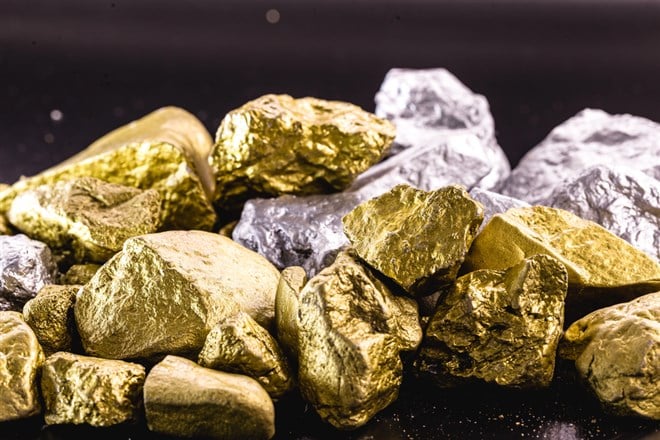Ticker Reports for November 6th
The Metals Market Is Heating Up—4 Stocks Poised to Shine
It’s one of the fastest-growing markets out there, yet most investors are still ignoring it.
Gold has climbed from about $1,800 an ounce to nearly $3,000, and according to Stansberry Research’s Brett Eversole, that’s just the beginning. He believes this bull market could ultimately send gold to $8,000–$10,000 per ounce before it’s all over.
That might sound bold, but the data—and the investor behavior behind it—tell a convincing story.
A Shift in Who’s Buying Gold
For years, central banks have been the driving force behind higher gold prices. Between 2022 and 2024, global institutions were steadily selling Treasury bonds and buying gold instead. But retail investors? They were nowhere to be found.
Now, that’s starting to change.
Eversole points to a key indicator: shares outstanding in gold ETFs like SPDR Gold Shares (NYSEARCA: GLD), which had been falling for years. That trend has finally reversed. ETF shares are climbing again—a sign that individual investors are moving back into the market.
And when retail investors finally catch on to a boom, history shows what happens next:
- The trend accelerates
- Valuations rise fast
- The boom eventually turns into a bubble
But, as Eversole puts it, “Between now and then, there’s a lot of money to be made.”
Why Gold (and Silver) Still Have Room to Run
Markets move in cycles. The last major gold boom began in 2001 and lasted a decade, with prices rising roughly 600% before peaking. The current cycle began in 2018, meaning we’re only about seven years into a similar long-term trend.
If history repeats, gold could roughly double from here—and silver may do even better.
Silver has always been the “wild card” of the metals world: more volatile, more speculative, but also capable of far greater percentage gains once momentum builds. Eversole believes we’re reaching that stage now.
If gold hits $8,000, silver could reach $200 an ounce. That’s roughly 4x potential upside from current levels.
And that makes the right mining stocks particularly compelling right now.
4 Mining Stocks That Could Lead the Metals Boom
There’s more than one way to invest in a bull market—and these four names are proof of that. They aren’t household names (yet), but Brett Eversole believes they’re the ones with the most room to run as gold and silver keep moving higher.
First Majestic Silver: A Pure Play on Silver’s Breakout
If silver takes off in the late stage of this bull cycle, First Majestic Silver (NYSE: AG) could be one of the biggest beneficiaries. The company is headquartered in Canada, but all its mining operations are in Mexico—and about 60% of its revenue comes from silver.
This is not a newcomer to metals rallies. “During the early 2000s, they were up five or six hundred percent in a couple of years,” Brett says. “Coming out of the financial crisis, they were up a couple of thousand percent.”
That kind of historical performance matters. It tells us First Majestic doesn't just rise with silver—it can soar.
Hecla Mining: A Low-Cost Producer with Big Leverage
Hecla Mining (NYSE: HL) gives investors exposure to both gold and silver, with production split roughly 50/50. But what really sets Hecla apart is where it operates—and how much it costs them to do so.
“They’ve got strong assets in good places and they’re a low-cost producer,” Brett notes. “Their cost to pull an ounce of silver out of the ground is around $13 an ounce. That’s about half what the industry average is.”
That cost advantage becomes a powerful engine when metals prices move higher. Hecla’s low base allows it to capture more profit on every price increase—without the risk of exotic jurisdictions or unproven operations.
Equinox Gold: From Builder to Cash Generator
Equinox Gold (NYSEAMERICAN: EQX) is no longer in asset-accumulation mode. After years of investing in growth, it’s now shifting into profitability—right as gold prices are accelerating.
Production is projected to increase from 800,000 to 1.2 million ounces by 2027, while costs are expected to fall from $1,900 to $1,500 per ounce. It’s the kind of operational pivot investors look for.
“This company is going to turn into this just like cash gushing machine,” Brett says. With projected free cash flow jumping from around $80 million to $1 billion, Equinox is transforming into a miner built for the moment.
Seabridge Gold: A High-Upside Bet on What’s Still Underground
Seabridge Gold (NYSE: SA) doesn’t currently produce gold—but it could hold one of the most valuable undeveloped gold and copper assets in the world. The company’s flagship KSM project in British Columbia is estimated to contain $25–$30 billion worth of metals.
What it needs now is a partner. “I think that when that joint venture deal is announced… this is a massive upside catalyst for the stock,” Brett says.
Because of its structure, Seabridge is highly leveraged to the price of gold. As prices rise, the economic value of its reserves climbs dramatically. If a joint venture is announced while gold continues climbing, Seabridge could reprice fast—and hard.
Why the Rally Still Has Room to Run
This isn’t just a short-term surge. Eversole argues we’re still early in a global boom that’s lifting nearly every asset class:
- Stock markets around the world are at or near all-time highs
- Mid-cap and small-cap equities are breaking out
- Gold and silver are surging alongside them
When multiple sectors and geographies rally together, it usually signals real global strength—not just a temporary rush into one asset class.
The Risk—and the Opportunity
Yes, metals can be volatile. Gold has moved sharply in recent months, and a pullback wouldn’t be surprising. But Eversole sees that kind of dip as a buying opportunity, not a red flag.
The “mania phase”—when everyone’s talking about gold, when ads flood the internet, when retail piles in at the top—still hasn’t arrived.
We’re not there yet. And that’s exactly why there may still be time to position for what comes next.
The window for preparation isn't just closing — it's slamming shut.
The window for preparation isn't just closing — it's slamming shut.
Follow the Money: 3 Stocks With High Institutional Ownership
On average, the smart money owns around 70% of any given large-cap company’s float. For context, one of 2025’s high-flying stocks—Palantir (NASDAQ: PLTR)—currently has institutional ownership of just 45.65%, as investors remain concerned about the stock’s elevated forward price-to-earnings ratio of 244.02.
To that end, MarketBeat has identified three stocks with higher-than-usual institutional ownership that each warrant consideration in investors’ buy-and-hold portfolios.
Micron Technology: 80.84% Institutional Ownership
Micron Technology (NASDAQ: MU) has made a name for itself on Wall Street by being an integral player in the semiconductor space.
NVIDIA (NASDAQ: NVDA) may get the lion’s share of headlines in that space, but demand for Micron’s flash memory and solid-state drives has seen the stock gain nearly 150% in 2025 compared to NVIDIA’s 43.66% year-to-date (YTD) gain.
While NVIDIA’s institutional ownership stands at just over 65%, professional investors have bought up 80.84% of Micron’s float. In the past 12 months, 1,544 institutional buyers have injected $17.50 billion of inflows into Micron, easily outpacing the $11.17 billion in outflows.
The bulk of Micron’s YTD gain has come since Aug. 1, as demand for the company’s high-bandwidth memory and data center products has recently picked up momentum.
Supplementing that strength, the company has ongoing partnerships with companies like Advanced Micro Devices (NASDAQ: AMD), Astera Labs (NASDAQ: ALAB), and Intel (NASDAQ: INTC).
Vanguard and BlackRock, the two biggest owners of Micron’s stock, hold more than 196 million shares. Meanwhile, over the past 12 months, Capital World Investors—the third largest holder of Micron—increased its position by more than 30% to 70.81 million shares.
Netflix: 80.93% Institutional Ownership
Netflix (NASDAQ: NFLX) recently made headlines after announcing a 10-for-1 stock split.
Shares are up more than 23% so far this year—not spectacular, but still outperforming the S&P 500. Nonetheless, Netflix is still highly favored by Wall Street.
Among other factors, that’s partly the result of the subscription-based consumer discretionary company’s net income increasing nearly 94% from $4.49 billion in 2022 to $8.71 billion in 2024. On a trailing 12-month basis, Netflix’s net income is currently $10.43 billion, showing the uptrend in profitability is both strong and sustainable.
That’s something that institutional investors have also taken note of, with ownership standing at 80.93%. Over the past 12 months, 2,804 institutional buyers have outnumbered 1,838 sellers, with inflows of $65.51 billion easily surpassing outflows of $31.92 billion.
Netflix’s four largest holders—Vanguard, BlackRock, Fidelity, and State Street—hold a collective 111.87 million shares of NFLX. Meanwhile, the stock’s current short interest is just 1.44%.
Dutch Bros: 85.54% Institutional Ownership
When it comes to retail coffeehouse chains, Starbucks (NASDAQ: SBUX) and Dunkin are often the first two companies that come to mind—but Dutch Bros (NYSE: BROS) is the fastest-growing coffee chain in the United States by revenue
And while Starbucks’ institutional ownership is a respectable 72.29%, the Seattle-based company trails its growth-focused counterpart by a sizable margin.
Currently, 85.54% of Dutch Bros’ float is held by institutional investors.
The company—which will be operating in 23 states by the end of the year—has now beat earnings for 11 consecutive quarters, while its annual EPS grew by more than 1,030% year-over-year from 2023 to 2024.
Meanwhile, the company’s net cash from operating activities has increased 240.6% since 2021.
The smart money has taken note. Over the past 12 months, 361 institutional buyers have invested $2.65 billion, versus 190 institutional sellers pulling out $1.90 billion.
Over the same period, Vanguard—its biggest holder—has increased its position by more than 14% and now owns 11.335 million shares.
At the same time, Fidelity and BlackRock—the second and third largest holders of Dutch Bros—increased their positions by more than 17% and 28%, respectively, and together own 13.772 million shares.
Exposed: Washington's Quiet Money Grab Strategy
Exposed: Washington's Quiet Money Grab Strategy
Can Gold Mining Stocks Shine as the Metals Rally Falters?
After a sizable and consistent rally lasting the better part of two years, gold may have finally reached a limit. Achieving an all-time high near $4,400 per ounce in mid-October, gold has since pulled back to roughly $4,000.
Its year-to-date (YTD) performance is still strong at more than 48%—the S&P 500 has returned 16% in the same timeframe—but investors confident the safe haven metal would only continue to rise may be facing the possibility that this is not necessarily a given. Shifting trade policies, the threat of a major market correction, and other factors could still sway the price of gold either direction heading into the new year.
Holding the metal itself is, of course, not the only way that investors gain exposure to gold. Shares of gold mining firms provide indirect access to gold as well as potential exposure to the broader precious metals industry. While many of the leading gold miners have rallied this year at the same pace as gold itself (or at an even faster clip, in some cases), a pullback in the price of gold has already translated to a similar, though modest, decline for some of these firms. Analysts are largely bullish on several of the big players, and a sustained drop in share price could present a buy opportunity—but investors should exercise caution.
Impressive Financial Results for Barrick, But Legal and Leadership Risks Are a Factor
Barrick Gold Corp. (NYSE: B) is among the largest gold producers globally by both market capitalization and production volume, and this firm has benefited significantly from the gold rally in recent quarters.
Shares of Barrick roughly doubled so far this year, although they have fallen by more than 6% in the last month as the rally has faltered.
The firm posted strong earnings in the second quarter, including production gains in both gold and copper on a year-over-year (YOY) basis, better-than-expected revenue growth of over 16%, and free cash flow that more than doubled to $770 million.
With an influx of cash, the company was able to repurchase $268 million in shares and boosted its dividend by 50%.
With the gold rally continuing for much of the third quarter, the firm may see similar success when it posts subsequent earnings as well.
On the other hand, investors should be aware of certain risks. The company's ongoing legal dispute with the government of Mali over its mining operations in the West African nation shows no signs of being resolved. An abrupt leadership transition earlier in the fall introduces uncertainty and may even prompt renewed speculation about the possibility of a merger between Barrick and its primary rival, Newmont Corp. (NYSE: NEM).
Nonetheless, a majority of analysts—13 out of 17—see Barrick shares as a Buy, and they expect nearly 34% in upside potential going forward.
Agnico Firms Up Its Financial Footing
Another major gold mining outfit, Agnico Eagle Mines Ltd. (NYSE: AEM), has only slightly lagged behind Barrick's performance, rising by close to 92% YTD.
Agnico delivered third-quarter earnings results at the end of October, including record performance across multiple categories.
The firm produced an impressive 867,000 ounces, generating $1.1 billion in adjusted earnings and $2.1 billion in adjusted earnings before interest, taxes, depreciation, and amortization (EBITDA).
This boon has also allowed Agnico to reward its shareholders.
The company returned $350 million to stock owners last quarter while also reducing its debt by $400 million.
Agnico's strengthened position should insulate it if gold prices fall, but it still faces higher-than-usual royalty costs as well as a cash tax payment of $1.2 billion due in the first quarter of 2026. The company could boost production—plus expenses, at least in the near-term—thanks to its aggressive expansion with 120 new drill rigs in the first nine months of the year.
Investors are likely to appreciate the possibility of an enhanced dividend and attractive expansion prospects; analysts certainly do, with 16 out of 17 naming AEM a Buy with nearly 18% in upside potential.
Alamos Faces Production Challenges, But Cash Influx Should Help
Alamos Gold Inc. (NYSE: AGI) is much smaller than the other two firms above and has only climbed by 57% YTD.
Although the firm saw record free cash flow for the latest quarter as well as a healthy $462 million in revenue, it faces production challenges.
Despite calling for an 18% increase in production for the final quarter, Alamos is reeling from a week-long outage at one of its mills and a separate seismic event that has prompted management to reduce full-year production guidance by about 6%.
Alamos also recently completed the sale of its Turkish subsidiary for $470 million, freeing up substantial cash to direct toward expanding both its geographic presence and its production.
Although near-term costs will be high, as Alamos recovers its production following the events of earlier in the year it has the potential to continue to rise. AGI shares received a unanimous Buy from 12 analysts with a possible upside of almost 36%.
The $10,000 morning
The $10,000 morning






